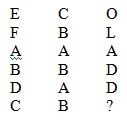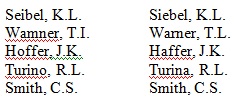The NFL Combine consists of several timed/scored physical drills that are designed to measure the various physical attributes of NFL prospects. Each drill measures different player abilities with sometimes enough overlap to confirm or call into question high or low scores in other drills. The combine attempts to measure speed, short area quickness (burst), lateral agility, upper body strength, lower body strength, explosiveness and other physical attributes through standardized physical drills. The drills are completed by players wearing track and field outfits as opposed to football pads and equipment, which has lead some scouts to nickname the combine “The Underwear Olympics.” When comparing scores and times amongst players of the same position, it is important to consider the context of how large the players are. When comparing players in general, remember that there are different standards for good scores for different positions.
The Forty Yard Dash as it’s name implies, involves a player running 40 yards as fast as possible. The clock starts on first movement, so players do not need to react to a gun. The forty yard dash simply measures sprinting speed over a Forty Yard distance and warrants little other explanation. Often the first 10 yards of the forty time are considered the most important – depending on position – as it helps to illustrate how quickly a player can accelerate to his full speed which can be more important than how fast he runs the next thirty yards. This is referred to as a “10 yard split.” A 20-yard split may also be used to measure how well a player can sustain his initial burst. The 40 yard dash should also be taken in the context of the size of a given player. A 6’4″ 220 lb player who runs a 4.40 is more impressive than a 5’9 170 lb player with the same forty time.
The Bench Press measures pure upper body strength and endurance. The NFL Combine version of the test involves the players bench pressing a 225lb barbell for as many reps as they can, until failure. The Bench Press score is listed as number of reps, which refers simply to the number of times the player was able to lift the 225lb weight. Like 40 time, the context of player size and position should also be taken into consideration when comparing Bench Press numbers. A 25 rep bench press score by a 350 lb lineman with is much less impressive than a 25 rep bench press score by a 225 lb wide receiver.
The Vertical Leap measures explosiveness and lower body strength. The drill is conducted simply by having the player leap from a stationary position and attempt to touch plastic flags at the top of a pole. Each player is given two opportunities to jump, with the highest point achieved counted as the measurement. Vertical leap translates nicely into a measure of how quickly an athlete can explode off the line of scrimmage from a motionless position. Vertical leap can also be used to confirm a fast 40 yard dash time or 10 yard split, as it involves many of the same muscle groups as sprinting. Like other drills, high vertical leap scores by heavier players are, relatively speaking, more impressive than their lighter counterparts.
The Broad Jump is another drill that measures an athletes lower body strength and explosiveness, but is also a good measure of balance. The drill is conducted with players standing behind a line with their feet and shoulders square to that line and in a stationary position. The player is allowed to swing their arms (while maintaining balance) and jumps forward with both feet to land as far as possible from the starting line. The athlete must show balance on the landing of the broad jump, as scores in which the athlete does not “stick the landing” are not counted.
The Three-Cone Drill measures many things including lateral quickness and change of direction ability, flexibility and body control and a bit of agility and speed. The drill involves 3 cones placed in a right-triangle formation with the cones placed 5 yards apart, forming the legs of the triangle. The athlete is asked to start from a 3-point stance and must react to a command to begin the drill. The player runs from the start to the first cone where he must touch the line, and then returns to the start where he must touch the line again. After the second line touch at the start, the athlete must run around the outside of the first cone, weave back inside and run around the second cone and then backtrack his steps to the finish line. The player is given two attempts at the 3-cone drill, one starting from each direction. This drill is a good measurement of skill-position change of direction explosiveness, but also a good measure of hip flexibility in pass rushers to show that they can bend sufficiently to get around the edge.
The 20-Yard Shuttle Drill is also known as the “5-10-5 drill,” the “pro agility shuttle” or the “short shuttle” drill. This drill measures short-area quickness, agility, flexibility and the speed at which a prospect can change direction. In addition to flexibility and athleticism, this drill gives scouts an idea of how well a prospect can sink their hips, keep a low center of gravity, and move laterally. This drill consists of three cones being placed 5 yards apart, with the player starting at the middle cone. The athlete begins the drill in response to a verbal “Go” queue, and chooses a direction to turn and run 5 yards to the cone. The player must touch the line, and then turns and runs to the other cone that is now 10 yards away. The player touches the line at the opposite cone, turns and runs the remaining 5 yards back to the original starting position. The time recorded is the total time taken to run between the cones in this manner. Athletes are given three opportunities to complete the drill, with the best time being recorded as their score.
The 60-Yard Shuttle Drill is also known as the “long shuttle” and is named for the total number of yards covered during the drill. The long shuttle measures speed, short area quickness, and the ability to change direction while sprinting at full speed. The drill consists of a starting line with three cones being placed 5, 10 and 15 yards from the starting line. The athlete must touch the line at each turn, and runs from the start to the 5 yard cone and back to the start (10 yards), to the 10 yard cone and back to the start (20 yards), and to the 15 yard cone and back to the start (30 yards). The sixty-yard shuttle is typically run by cover linebackers and defensive backs and offensive skill positions including tight end, but quarterbacks and offensive/defensive linemen typically do not participate in this drill.
Body measurements (Height, Weight, Hand Size, Arm Length) simply measure the size of an athlete’s body. These measurements are often important to give context on how athletic a player really is, as well as show whether or not a player is of sufficient size for his position. Height is usually considered most frequently when evaluating QBs, WRs, and CBs with Weight being more important when looking at Defensive Tackles. Arm Length is used primarily when evaluating Offensive and Defensive lineman, and Hand Size is often cited as an important metric for Quarterbacks and Wide Receivers.
The Cognitive Tests feature a Wonderlic test and a 60-minute aptitude test. The Wonderlic is a basic cognitive ability test consisting of 50 multiple-choice questions that must be answered within 12 minutes, with the score being the number of questions answered correctly within that period of time. According to Wonderlic, Inc. a score of 20 indicates average intelligence and a score of 10 indicates at least a basic level of literacy. The Wonderlic test is controversial in terms of it’s usefulness in determining actual intelligence, especially in the context of NFL football. Wonderlic scores are not officially reported by the NFL, but usually leak out to media during draft coverage. Little is known about the new cognitive aptitude test that the NFL introduced in 2013. It is known to be 60 minutes long and “impossible to study for,” and held in a fairly high level of confidentiality. It is speculated that the aptitude test is a hybrid of a personality test and an intelligence test, possibly helping teams evaluate whether a player is a fit for their coaching styles. Scores for the aptitude test have been rumored to be shared with only a few executives per team to maximize the security of that information.
What separates players by combine scores is not only the score itself, but typically what position they play. The size of the player, as mentioned above, is also a good indicator of how athletic a player is, as it’s more difficult to be fast when you are also big and tall. Context is always important when evaluating players based on combine data, but the combine does put players on an even playing field by standardizing the drills and measurements taken.





